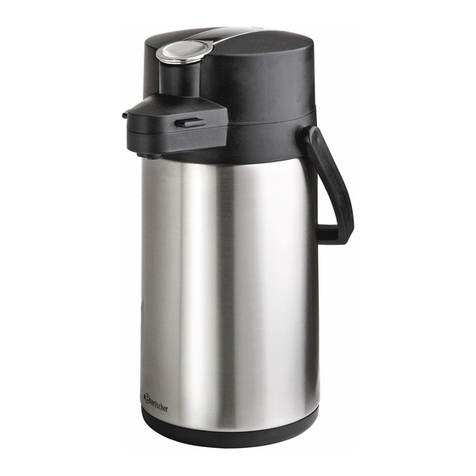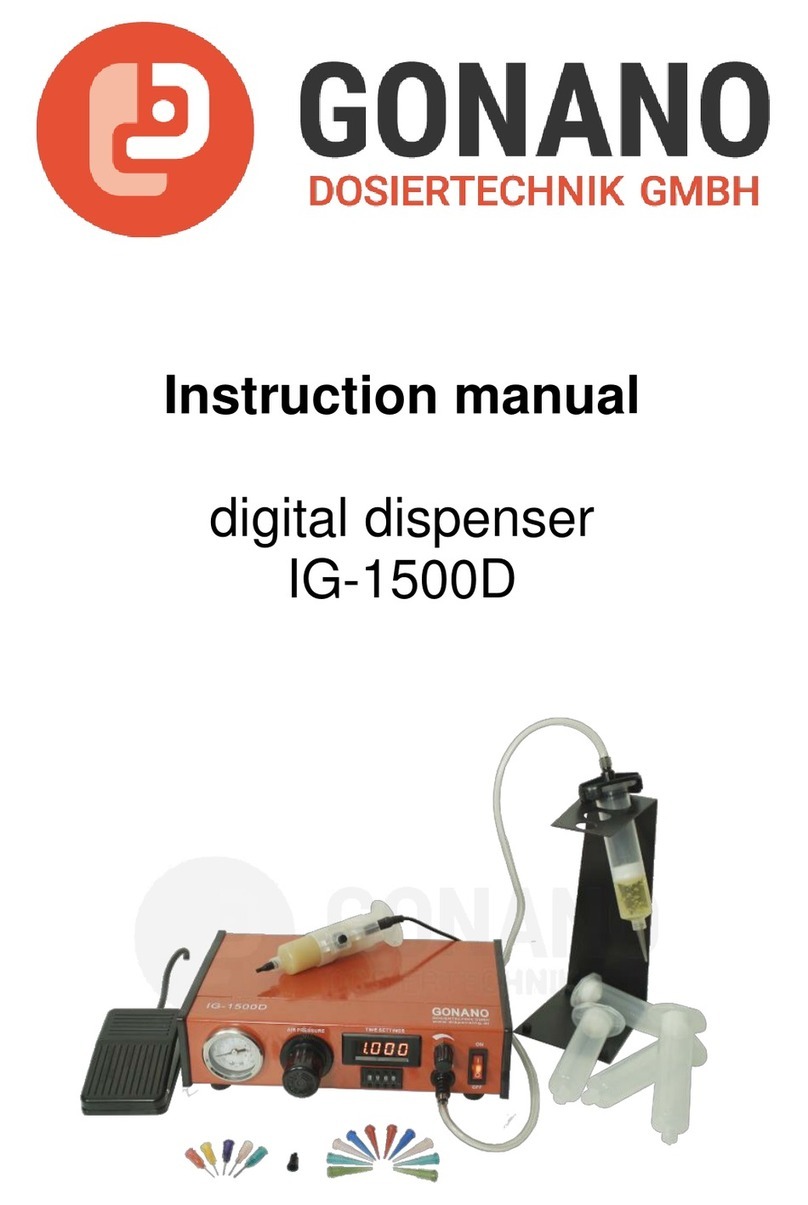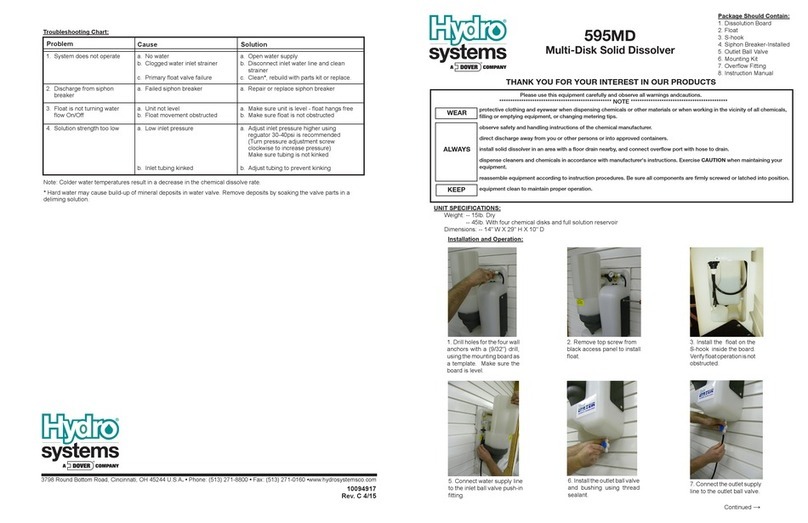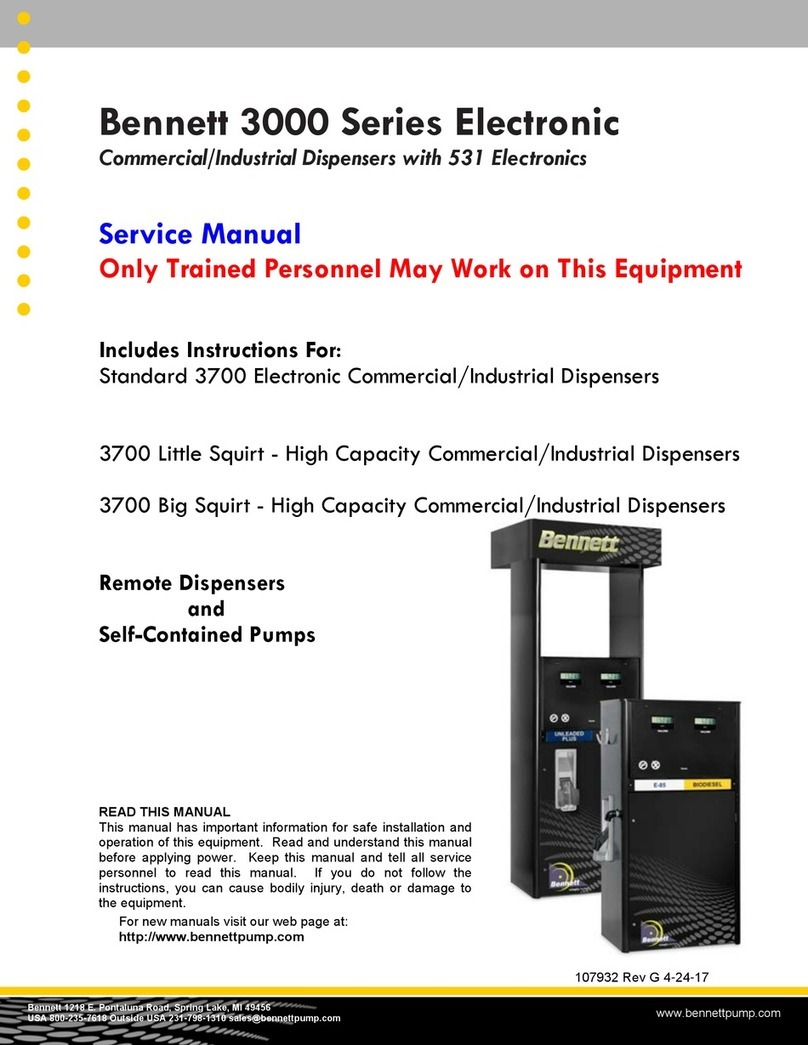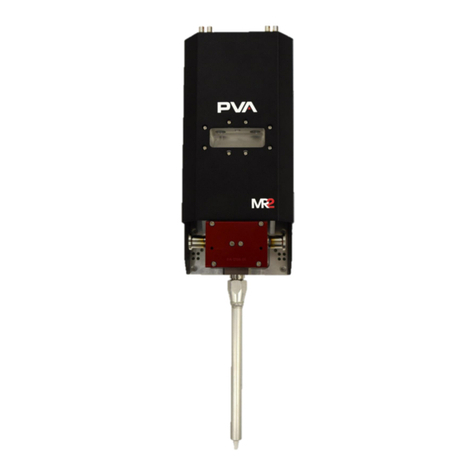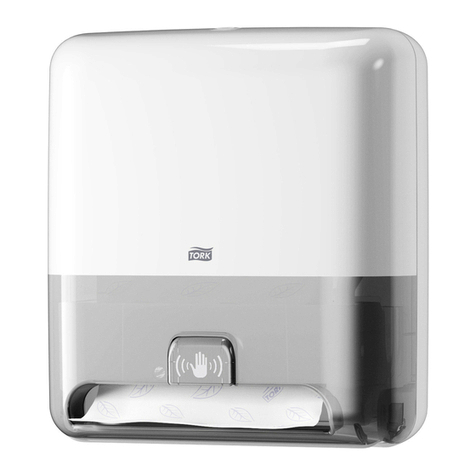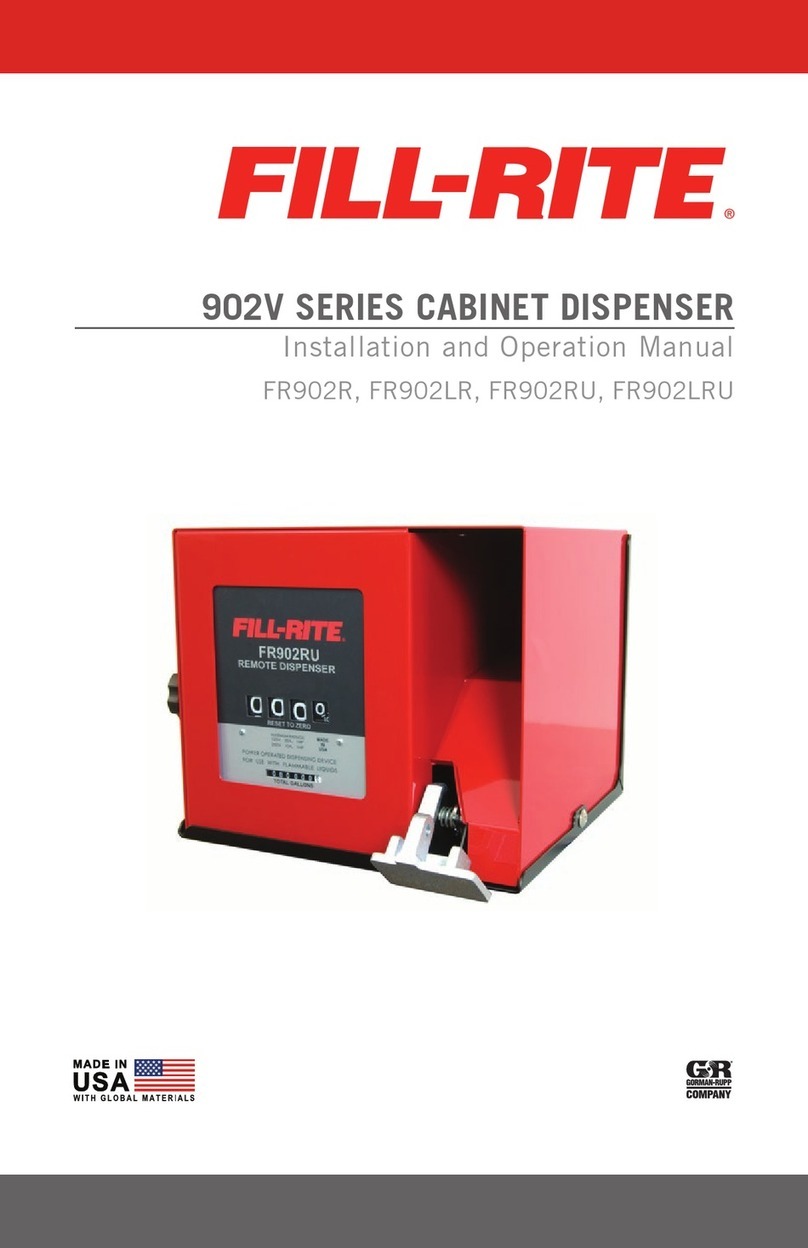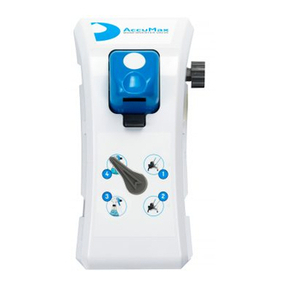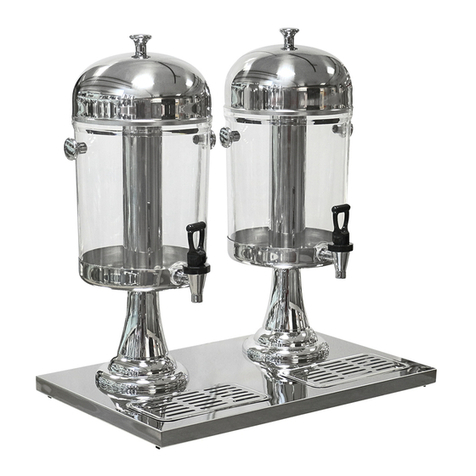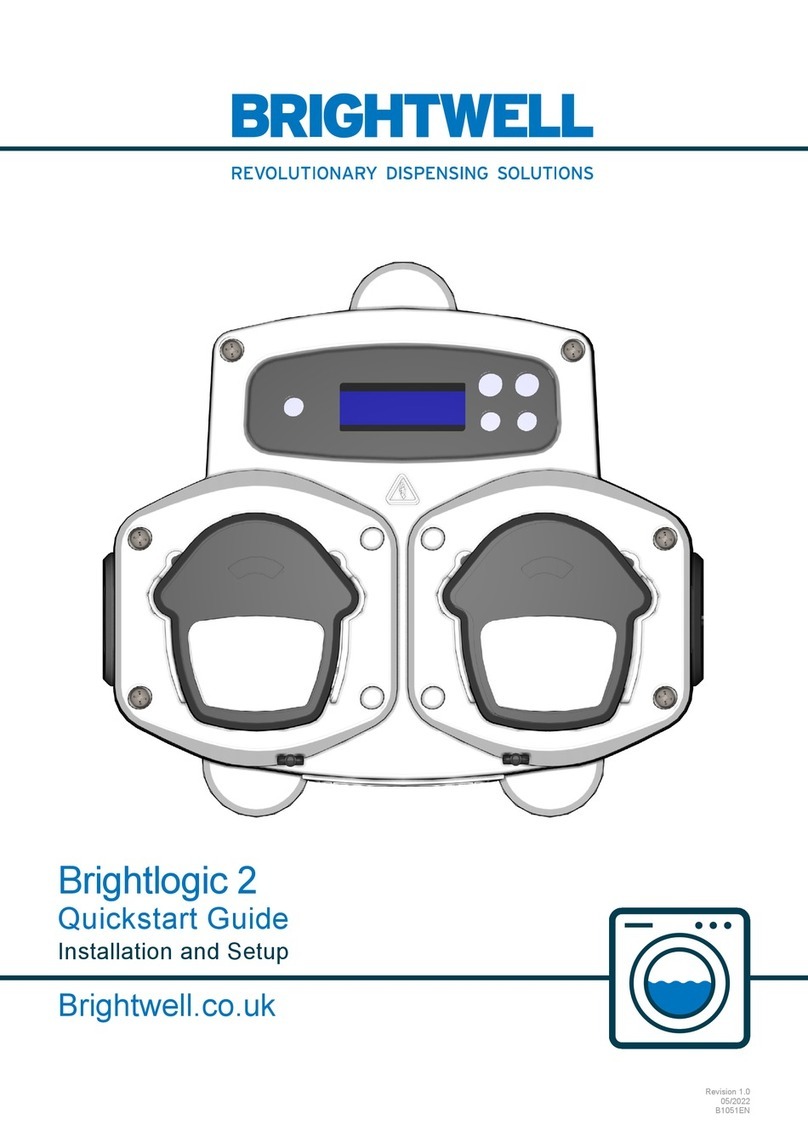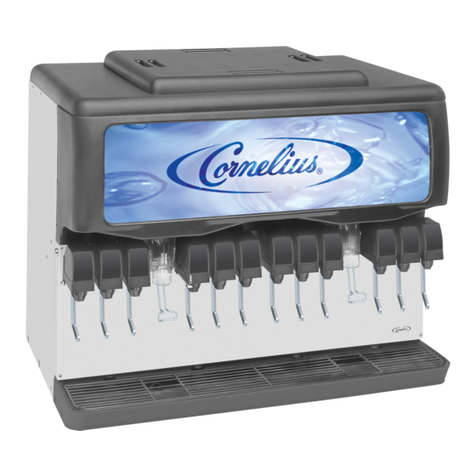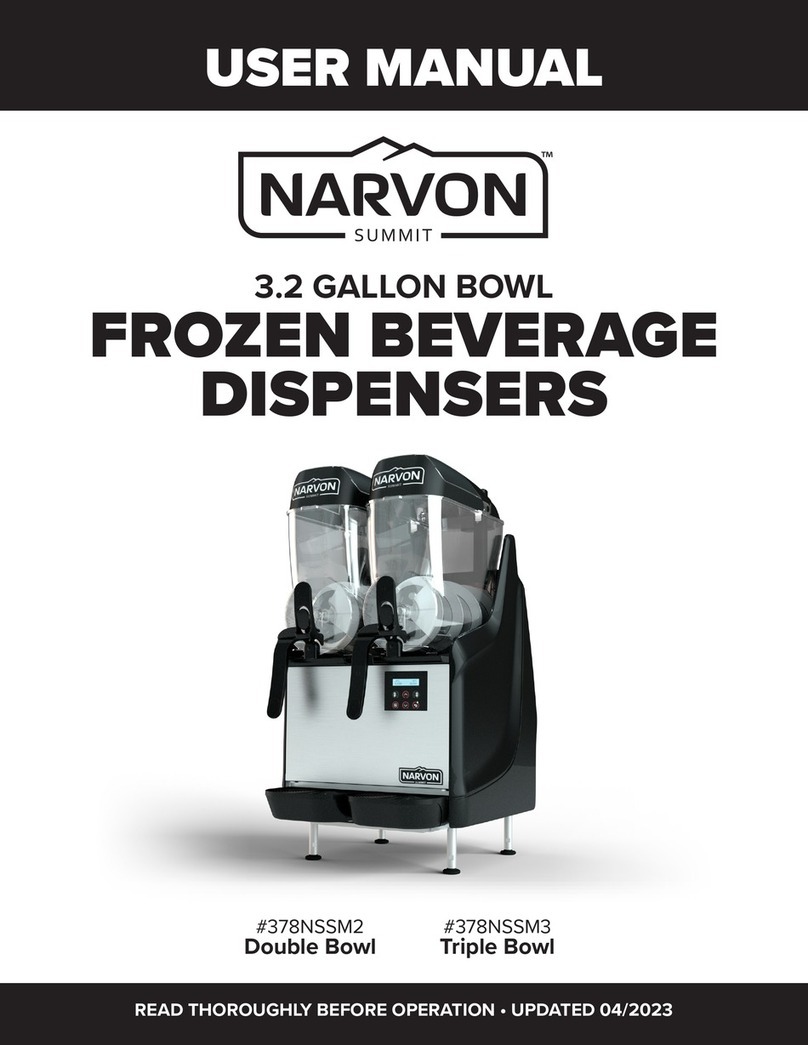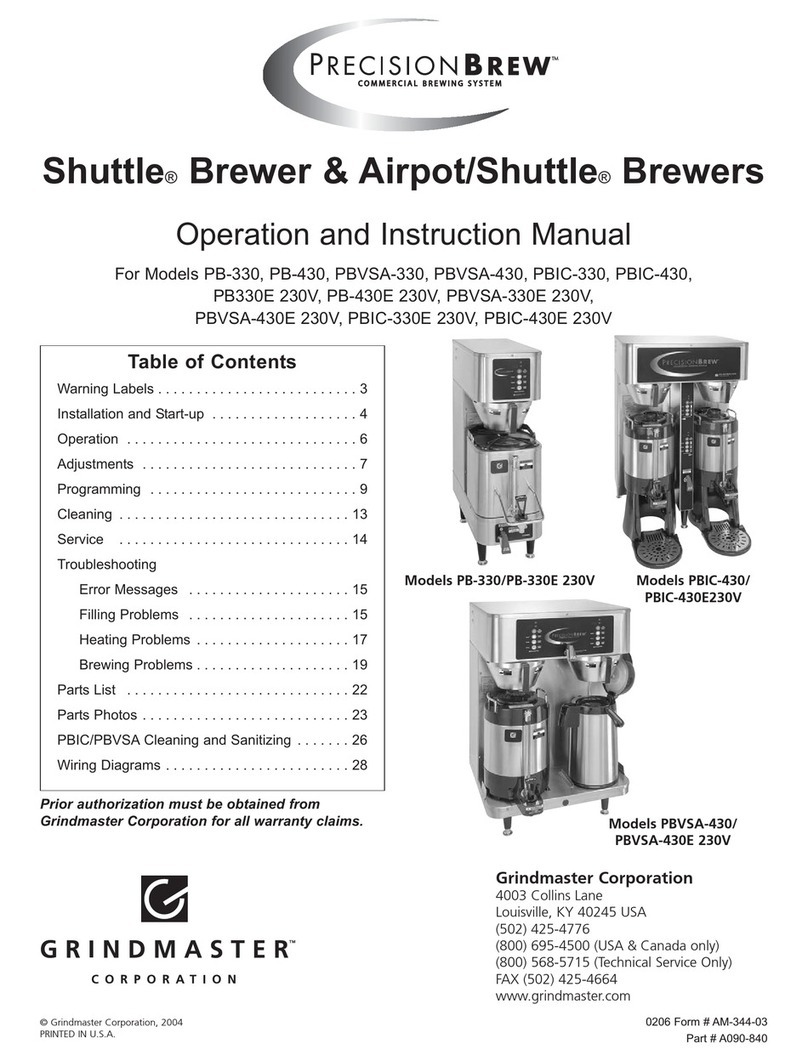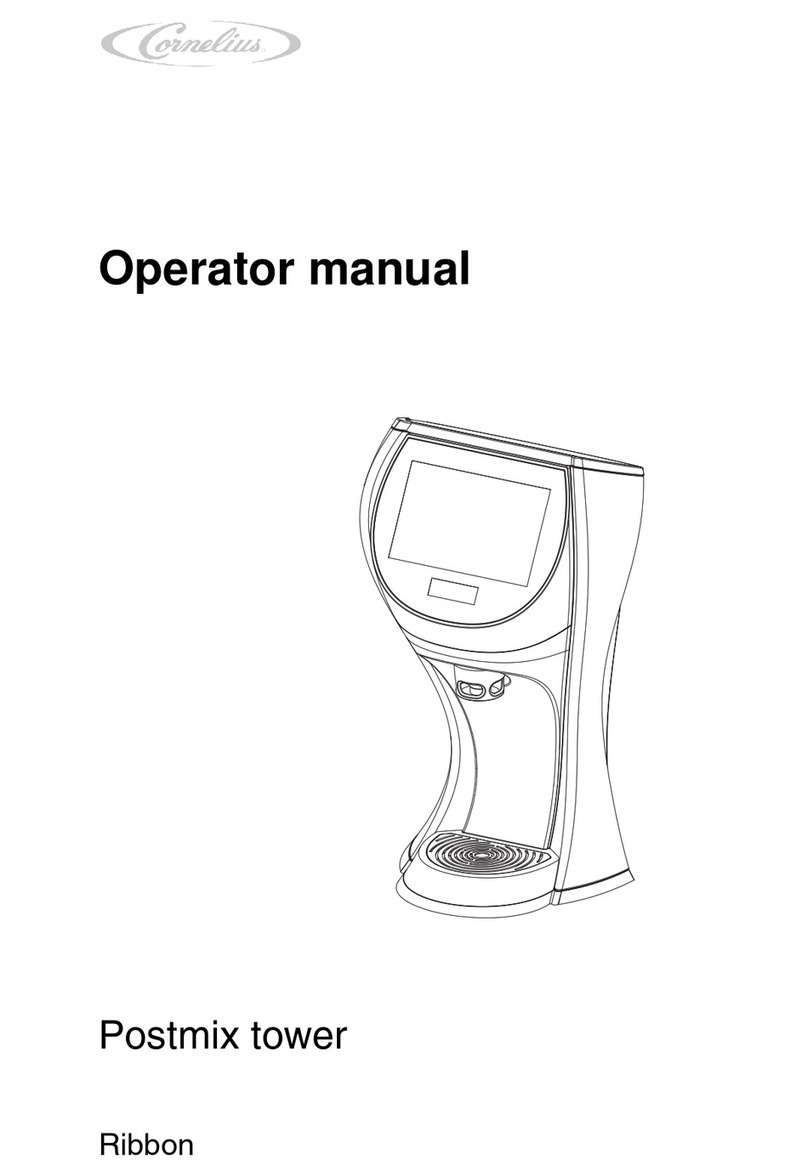Bores PROTHO User manual

INSTRUCTION MANUAL
Peristaltic Pump for cleansing agents
PROTHO

2
PROTHO Technical Manual Bores Group S.r.l.
(Rev. 01 del 151008)

3
PROTHO Technical Manual Bores Group S.r.l.
Dear Customer, congratulations for having chosen a quality product that will definitely meet your needs. While thanking
you for your choice, we kindly ask you to carefully look at this Instruction manual before using your new peristaltic
metering pump.
INDEX
1 IMPORTANT DIRECTIONS AND RECOMMENDATIONS page 4
2 GENERAL CHARACTERISTICS page 4
2.1 FIELD OF USE page 4
2.2 FUNCTIONING PRINCIPLE page 4
2.3 RATING page 4
3 INSTALLATION page 4
3.1 POSITIONING page 4
3.2 CONNECTING TO THE MAINS SUPPLY page 5
3.3 WATER CONNECTIONS page 5
4 STARTING page 6
4.1 REGULATING THE CAPACITY page 6
5 MAIN CAUSES OF FAILURE TO FUNCTION page 7
6 MAINTENANCE AND CLEANING page 7
6.1 PERIODICAL CHECKS page 7
7 PERIODS OF NON-OPERATION page 7
8 DIRECTIONS FOR THE MAINTENANCE FITTER page 7
9 WARRANTY TERMS page 8
10 TECHNICAL INFORMATION page 9
11 EXPLODED VIEW OF THE METERING PUMP WITHOUT CONTAINER page 10
12 EXPLODED VIEW OF THE METERING PUMP WITH CONTAINER page 11
13 ACCESSORIES AND SPARE PARTS page 12

4
PROTHO Technical Manual Bores Group S.r.l.
1 IMPORTANT DIRECTIONS AND
RECOMMENDATIONS
This instruction manual is an integral part of the
peristaltic metering pump (also more simply
defined in this instruction manual with the terms
pump or device) and must be kept for any future
consultation.
If the device is sold or transferred to another person,
this manual must be handed over to the new user so
that she/he will be informed about its functioning and
the relative directions.
Read the directions contained in this manual
carefully before installing and using the pump.
These directions have been drawn up for safety
during installation, use and maintenance.
Any directions or diagrams that refer to special
models will be supplied enclosed in this manual.
Always remove the plug from the power socket
before proceeding with any maintenance or
cleaning operation.
Any intervention or modification to the electrical
installation that might be necessary, must be carried
out exclusively by skilled and qualified personnel.
This pump is only for the dosage of additives
(detergent or rinse aid) in dishwashing machines.
Any use of the metering pump that is not the
dosage of additives in dishwashing machines is to
be considered improper.
It has been designed to be used by adults, therefore
stop children getting close to it with the intention of
playing.
As well as invalidating all forms of the warranty,
modifying or trying to modify this device is extremely
dangerous.
In order to guarantee the efficiency of the device
and for it to function correctly, you must follow
the Manufacturer’s instructions and have the
maintenance done by professionally qualified
personnel.
Never try to repair it by yourself because as well as
being dangerous, the intervention of people who are
not experts can cause or worsen the damage. If there
is a fault, contact the distributor who sold it to you or
the Manufacturer, who will recommend the nearest
Service Centre. We suggest you always ask for
original spare parts only.
When the pump has to be demolished, we remind you
to make it inoperative removing the power cord (after
having disconnected it from the mains supply, of
course).
We also remind you to:
∗Avoid throwing the components of the metering
pump away into the environment.
∗Arrange for the disposal and the recovery of the
materials in accordance with the relevant national
laws in force.
For this reason we urge you to give maintenance
work and recovery of any replaced components
exclusively to authorised service engineers.
2 GENERAL CHARACTERISTICS
2.1 FIELD OF USE
The peristaltic pumps in the “PROTHO” series are
available in two versions:
-without the container, for use inside dishwashers.
-With the container, for external use.
The functional characteristics of the metering pumps
with the container is, if necessary, completed with
different technical solutions that allow a practical and
effective regulation of the capacity.
2.2 FUNCTIONING PRINCIPLE
Peristaltic pumps are the best that exist in the
metering pumps sector as they do not have valves,
which cause considerable problems.
The functioning principle is based on the elasticity of
the membrane pipe for pumping and on the
alternating sliding compression of the rollers
supported by the central rotor of the device. This
support, driven by a motor reducer, whilst turning,
puts the suction and injection functions into operation
simultaneously.
Suction occurs because of depression, after the
passage of the rollers, thanks to the elasticity of the
pipe, while injection occurs following the sliding
compression of the rollers on the pipe which push the
product towards the outlet.
2.3 RATING
The voltage, frequency and capacity values are
shown on the data plate. Refer to this for all checks
and verifications.
3 INSTALLATION
When delivered the metering pump is protected by a
cardboard packaging (fig. 1).
Open the cardboard packaging, avoiding the use
of unsuitable tools such as knives, penknives,
screwdrivers, etc. and make sure the device is
intact. If you have any doubts about this, DO NOT
USE IT and contact the Distributor or the
Manufacturer who sold it to you.
None of the packaging (bags, cardboard, polystyrene
foam, staples, straps, etc.) must be left in the reach of
children as they are potential sources of danger.
Skilled and qualified personnel must carry out the
installation observing the national laws in force
and following the Manufacturer’s instructions.
Incorrect installation can cause damage to the
environment, animals, people and objects, for which
the Manufacturer cannot be considered responsible.
3.1 POSITIONING
The device has been designed and manufactured to
be installed internally or externally (models with

5
PROTHO Technical Manual Bores Group S.r.l.
container) to a dishwashing machine that controls it
in order to perform the necessary functions.The
device
must be positioned maintaining suitable distances
from the other components of the machine in order to
allow ease of maintenance. This expedient must also
prevent accidental leaks of the product from the
pump, following the breakage of the pumping pipe,
from damaging the surrounding components.
3.2 CONNECTING TO THE MAINS SUPPLY
The electrical safety of this device is only
obtained when it is installed in the dishwashing
machine observing the national safety laws in
force.
The dishwashing machine must be installed by skilled
and qualified personnel.
The Manufacturer cannot be considered
responsible for any damage caused by the
incompetence or carelessness of the installer.
Check that the electrical capacity of the system is
adequate for the maximum power of the metering
pump shown on the data plate.
The installer must also make sure that the cross-
section of the wires in the electrical system is suitable
for the absorbed power of the device.
The peristaltic metering pump for internal fitting
has no switch, therefore the supply voltage
causes the device to start immediately.
The installer must also find the connection points for
the feed to the peristaltic metering pump.
To feed a metering pump for detergent a parallel
connection to the rinsing solenoid or an equivalent
point must be made.
While for a metering pump for rinse aid a connection
to the washing pump of the dishwashing machine or
an equivalent point must be made.
If the detergent metering pump is supplied with
conductimetric regulation, a detergent sensor will
have to be installed and a 12.5 mm Ø hole drilled in
the dishwasher tank, below the water level. (If the
machine that needs the additive is already in service,
remember to empty the washing tank before carrying
out the above operation). After drilling the hole
position the sensor with the gasket for the hole and
tighten the relative nut from the outside of the tank.
Do not overtighten in order not to damage the various
components.
Now connect the wires that come out of the pump
container:
∗one to earth (to the casing of the machine)
∗the other to the fastener on the detergent sensor
previously installed.
We remind you to protect the metering pump feed
wires making sure that they do not get squashed or
damaged in any way.
Read the following directions carefully
Using the metering pump, as with any other electrical
device, entails complying with some fundamental
rules, such as:
∗Do not touch it with damp or wet hands and feet
∗Do not use it when you are bare-footed
∗Do not use extension cables in rooms used as
kitchens, bathrooms or shower rooms
∗Never pull the power cable to disconnect it from
the mains supply
∗Do not let children or mentally incompetent people
use it.
Before carrying out any cleaning or maintenance
operations disconnect the machine that controls
the metering pump from the electrical supply and
remove the plug from the power socket.
If there is a fault on the device or it functions
poorly, turn it off following the procedure
described above and do not carry out any
improvised repairs or direct interventions.
Instead, contact professionally qualified
personnel only and demand the use of only
original spare parts. Failure to comply with what
is written above, besides invalidating all forms of
the warranty, can seriously jeopardise the correct
functioning of the device.
3.3 WATER CONNECTIONS
This peristaltic metering pump is only meant for
the dosage of additives in dishwashing
machines.
Skilled and professionally qualified personnel must
make the water connections following the
Manufacturer’s instructions and using the
components supplied in the kit specifically for
installation.
These connections are divided into two distinct
stages:
1) Suction circuit
2) Injection circuit
1) Connecting the suction circuit (fig. 2)
- Connect the suction pipe to the pipe fitting (see
indicating arrow) and then reach the tank with
the product that has to be sucked up with the
other end.
- Cut off any excess pipe and install the bottom
filter provided.
- Then put the bottom filter into the tank.
2) Connecting the injection circuit
Depending on the product to be injected, connecting
the injection circuit is divided into:
a) Injecting the detergent
b) Injecting the rinse aid

6
PROTHO Technical Manual Bores Group S.r.l.
a) Connecting the detergent injection
circuit (fig. 3)
- To install the relevant pipe fitting, drill a 12.5 mm
Ø hole in the tank above the water level in a
favourable position.
- Push the threaded part of the union elbow through
the previously drilled hole from the outside of the
tank (if necessary use a file to remove any burrs
that might prevent the gasket from sealing).
- Put the gasket on the thread of the union elbow
from the inside of the tank and then carefully
tighten the relevant bolt. Do not overtighten in
order not to damage the components of the union
elbow.
- Connect the pump’s injection pipe fitting to the
union elbow previously installed in the tank using
the special pipe supplied.
a) Connecting the rinse aid injection circuit
(fig. 4)
When there is this type of installation you have to
identify the ideal point for fitting the components,
considering their dimensions and easy access for
being able to install them readily.
- Remove the rubber pipe into which the product
will be injected.
- Push the end of the previously cut pipe onto the
union tee (T Venturi) making sure that the water
flow follows the direction stamped on the union
tee itself.
- Block the rubber pipes previously fitted onto the
union tee with two metal clamps (not supplied).
If the dishwashing machine is already fitted with a
special injection pipe fitting, a rinse aid injection valve
that allows you to eliminate the operations described
above, is available on request.
- Using the pipe supplied (made of polyethylene)
connect the delivery pipe fitting of the pump to the
injection pipe fitting, with a nonreturn valve,
locking the threaded locking rings carefully.
4 STARTING
Once the electrical and water connections of the
metering pump are complete you can proceed to
starting it. When starting the pump for the first
time, the dishwashing machine has to perform
several washing cycles on empty to allow the
device to fill the pipes in the injection circuit.
This snag can be overcome by manually priming the
pump as follows:
ATTENTION!!
This operation is valid only for models with
asynchronous motors (motors without brushes).
On the other hand in the other models, with motor in
continuous cycle (with brushes), it is NOT POSSIBLE
to make this operation.
- Take the utmost care to check the direction of
rotation of the pump, since an incorrect manoeuvre
could irreparably damage the motor reducer of the
device.
- Turn the rollers support rotor in the direction of
rotation of the pump (see arrow) using a 6 mm
setscrew (Allen) wrench in the hexagonal hole on
the device until the circuit is completely full (fig. 5).
This operation must be carried out by skilled and
qualified personnel only when the pump is
started for the first time and after each time the
pumping pipe is replaced.
- Check that there are no leaks from the water
connections.
4.1 REGULATING THE CAPACITY
The functional characteristics of the metering pump
are completed with some technical solutions:
- intermittent electronic regulation (fig. 6)
this regulation allows you to vary the capacity of the
pump quickly and rapidly by turning a special knob
on the front of the container of the device.
- conductimetric electronic regulation (fig. 7)
this regulation, on the other hand, allows you to keep
the concentration of the detergent in the water of the
dishwasher’s washing tank constant. To increase or
decrease the dosage, turn the knob on the front of
the container of the metering pump manually.
Specialised personnel must do these regulations
as several checks must be done on site, such as:
the type of detergent used and any hardness in
the water, etc.

7
PROTHO Technical Manual Bores Group S.r.l.
5 MAIN CAUSES OF FAILURE TO
FUNCTION
If the additive is not injected the User must verify and
check:
- whether there is any of the product to be
consumed in the storage tank
- whether the filter is blocked
- whether the electric current is on
If faults occur or are found that are different to the
above, such as:
- difficulty in sucking up the product to be
injected
- rapid and continuing emptying of the suction
pipe after each functioning
- breakage of the pumping pipe
- breakage of the motor reducer
- breakage of the electronic card
It is a good idea to contact a Service Centre as
maintenance is necessary.
For a rapid and efficient intervention it is important
when calling to indicate precisely the model of the
pump, which can be seen on the data plate.
6 MAINTENANCE AND CLEANING
Before carrying out any type of maintenance
work on the device you must turn off the power
and remove the plug from its socket.
The component that needs maintenance is:
- the pumping pipe (fig. 8)
the efficiency of the pump is linked to this
component so it must be periodically replaced, at
least every 3 months, in order to guarantee a
constant capacity to the device itself. This also
prevents the pipe from breaking through wear.
Maintenance on this component must be carried out
by competent and professionally qualified personnel
from a Service Centre and demanding the use of
original spare parts.
The component that needs cleaning is:
- the suction filter (fig. 9)
The filter will have to be periodically washed in case
the additives used contain sediments that prevent
the product being sucked up to the pump itself.
The state of the filter must be checked each time
the pump is refilled with the product. When cleaning
the filter protect your hands with rubber gloves.
6.1 PERIODICAL CHECKS
The device must be periodically checked and if
necessary refilled with the consumed product. Also
verify that there are no leaks in the water circuit.
7 PERIODS OF NON-OPERATION
If a long period of non-operation is expected,
when the pump is going to be used again an extra
repair must be carried out, replacing the pumping
pipe (fig. 8)
This operation is necessary because the product that
has remained in the pipe tends to solidify removing
the natural elasticity of the pumping pipe.
Skilled and qualified personnel must carry out this
maintenance.
8 DIRECTIONS FOR THE
MAINTENANCE FITTER
All the operations that entail working on circuits
or internal parts, for the performance of which
electrical protection devices have to be removed,
must be carried out with the device stopped and
only after having turned off the voltage.

8
PROTHO Technical Manual Bores Group S.r.l.
The device can only be energised for starting once
the operations are concluded and once you have
moved away from the device
. 9 WARRANTY TERMS
•This peristaltic metering pump (defined in the
following points more simply as pump or
device) is guaranteed for a period of one year
from the date of purchase which is proved by a
document valid for fiscal purposes issued by
the Retailer or the Manufacturer, which shows
the date in which the purchase was made.
•The fiscal document that proves the date of
purchase, issued by the Retailer or the
Manufacturer, must be kept together with this
instruction manual; both must be exhibited to the
technical personnel in the case of work done in the
warranty period.
•Warranty is understood to be the free replacement
or repair of the parts that prove to be defective in
origin or because of manufacturing flaws.
•The user is obliged to pay the “fixed call-out fee”
should she/he require the work to be done at
her/his own home.
•All the parts that prove to be defective due to the
carelessness of negligence in use (failure to comply
with the instructions for the operation of the device),
or incorrect installation and maintenance carried out
by personnel that are not professionally qualified,
transport damages, that is due to circumstances
that in any case cannot be traced back to
manufacturing defects in the device are not covered
by the warranty.
•Work inherent to the installation and the connection
of supply systems as well as the maintenance
mentioned in this instruction manual are also
excluded from the warranty services.
•The warranty is also excluded in all cases of
improper use of the pump.
•The Manufacturer declines all responsibility for
any damages that might, directly or indirectly,
be caused to people, objects and animals as a
result of the failure to comply with the
directions indicated in this instruction manual
and especially those which concern the
directions about the installation, use and
maintenance of the device.
•If the device is repaired at an Authorised Service
Centre or by the Manufacturer, the transport risks
are at the expense of the User.
In any case, the transport costs are understood to
be at the expense of the User.
•In any circumstance the extension of the warranty
in the event that a fault should occur is excluded.

9
PROTHO Technical Manual Bores Group S.r.l.
10 TECHNICAL INFORMATION
Some models in our range of products
Capacity Product
Model cc/” l/h
Tube
diameter Pressur
bar Detergent Rinseaid
PD1.5 0.41 1.5 6.4x1.6 0.1 *
PD2.0 0.56 2.0 6.4x1.6 0.1 *
PD3.3 0.92 3.3 6.4x1.6 0.1 *
PB0.4 0.11 0.4 3.2x6.4 3 *
PD3.3E 0.92 3.3 6.4x1.6 0.1 *
PD3.3ER 0.92 3.3 6.4x1.6 0.1 *
PB1.0E 0.28 1.0 3.2x6.4 3 *
PB1.0ET 0.28 1.0 3.2x6.4 3
PDF2.0 0.56 2.0 6.4x1.6 0.1 *
PBF0.4 0.11 0.4 3.2x6.4 3 *
PDE3.3 0.92 3.3 6.4x1.6 0.1 *
PDE4.0 1.12 4.0 6.4x1.6 0.1
PDER3.3 0.92 3.3 6.4x1.6 0.1 *
PBE1.0 0.28 1.0 3.2x6.4 3 *
PDE8.0 2.24 8.0 6.4x1.6 0.1 *
PDE8.024 2.24 8.0 6.4x1.6 0.1 *
PDER8.024 2.24 8.0 6.4x1.6 0.1 *
PBE2.0 0.56 2.0 3.2x6.4 3 *
PBE2.024 0.56 2.0 3.2x6.4 3 *
PDS4.0 1.12 4.0 6.4x1.6 0.1 *
PDS8.0 2.24 8.0 6.4x1.6 0.1 *
PDS8.024 2.24 8.0 6.4x1.6 0.1 *
PDBE3/1 0.84 - 0.28 3 – 1 6.4x1.6
3.2x6.4 0.1 – 3 * *
PDBER3/1 0.84 - 0.28 3 – 1 6.4x1.6
3.2x6.4 0.1 – 3 * *
PDSBE8/2 2.24 - 0.56 8 – 2 6.4x1.6
3.2x6.4 0.1 – 3 * *
PDBER8/224 2.24 - 0.56 8 – 2 6.4x1.6
3.2x6.4 0.1 – 3 * *
PDSBE8/224 2.24 0.56 8 – 2 6.4x1.6
3.2x6.4 0.1 – 3 * *
Available with voltages of 220 and 24 V ac – 50/60 Hz

10
PROTHO Technical Manual Bores Group S.r.l.
11 EXPLODED VIEW OF THE METERING PUMP WITHOUT CONTAINER

11
PROTHO Technical Manual Bores Group S.r.l.
12 EXPLODED VIEW OF THE METERING PUMP WITH CONTAINER

12
PROTHO Technical Manual Bores Group S.r.l.
13 ACCESSORIES AND SPARE PARTS
ILLUSTRATION OF THE
COMPONENT CODE DESCRIPTION
GOMDIC Stainless steel union elbow for
detergent injection, complete
SENSC Sensor for detergent
conductimetric control card
FILFIC
VALFC
- Stainless steel bottom filter,
complete
- Stainless steel bottomfilter with
non-return valve, complete
FILTR Bottom filter with rigid pipe
VALBD Non-returne valve for rinse aid
injection
TW T Venturi with non-return valve for
rinse and injection

13
PROTHO Technical Manual Bores Group S.r.l.
ILLUSTRATION OF THE
COMPONENT CODE DESCRIPTION
TUBSA6416DRC Santoprene pipe for detergent
complete with pipe fitting
TUBS3264ABC Silicone pipe for rinse aid
complete with pipe fittine with
non-returne valve
ROCPPC
ROCPPBC
- Support with Protho rollers, for
detergent, complete
- Support with Protho rollers, for
rinseaid, complete
CORPPA Protho pump body
TUBC46
TUBP46
- 3 m. Cristal PVC pipe for
detergent
- 3 m. polyethylene pipe for
rinseaid
Table of contents
